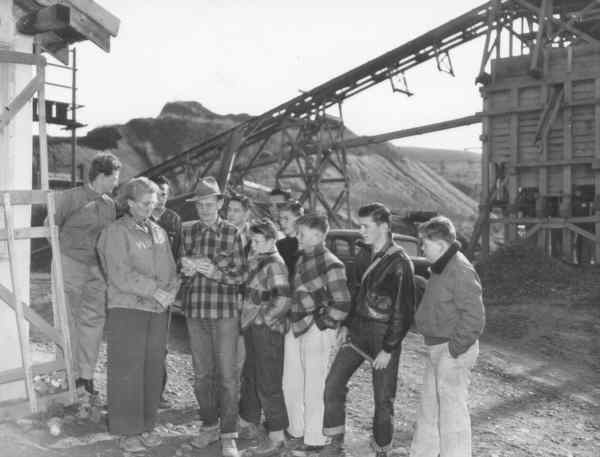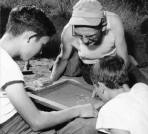Wesley Dexter Gordon Sr
Wesley Dexter Gordon, who worked at the Moore Shipyards in Oakland in the days before Pearl Harbor, came to the Meekland area of Hayward in the 1930's. Having taken courses in non-ferrous metals and allied subjects through Berkeley Extension, he joined the night school faculty of Hayward High School in 1939, teaching a course in Mineral Identification. His interest in minerals spread to rocks and fossils, and soon he was taking rock trips with Bounds Christian, Judge Jacob Harder, and other rock hounds as well as teaching Rock Polishing at Hayward High.
 |
 |
| Wes with his "boy paleontologist" | working alongside students |
In 1941, Mr. Gordon joined with interested citizens to develop the Recreation District for Hayward, supervised the Hayloft, the teen Center on B Street, and was, in 1942, appointed Superintendent of the the fledgling Recreation Department, a position he held for a year and a half. After the Hayward Area Recreation Department (HARD) was established in 1944, Wes was appointed Assistant Superintendent.
In the early forties, Wes taught at Russell School, where Wilda Mette was principal. During these years he attended summer school at Stanford earning a credential in science supervision that would enable him to accept a job promised him by Ethel War of the Alameda County School Board In 1947, he became Coordinator of Science for Alameda County and was assigned three days to the San Lorenzo School District and one day to Newark. His expertise and enthusiasm led to his being offered the full time job of Science Coordinator with the San Lorenzo schools, a position he held for twenty years, until he retired in 1972.
His responsibilities were many. He worked with classes of all ages from kindergarten through the senior year in high school. He oversaw the purchase of equipment, helped teachers to select appropriate textbooks, talked to students on a multitude of topics ranging from dinosaurs to constellations, insects to trilobites, and with the encouragement of Paul Ehret, took students to explore various museums, local creeks, and fossil sites. The most exciting fossils found were two partial skulls of a giant bear, that would have reached a towering 14 feet standing on its hind legs.
Through the auspices of the National Education Defense Act and Paul Ehret, Wes established a museum in the David E. Martin School located on Paseo Grande in San Lorenzo. For a year, he gave half of his time to the museum and half to students. By 1973 he was working full time at the museum, identifying specimens and arranging displays. A large portion of the Museum, called the Museum of Discovery, emphasized the ability of student to develop insights and reach conclusion. According to Wes, the real challenge was to select specimens that was so obvious to students, that they could formulate a conclusion.
Born in 1907 , Wes Dexter Gordon was the youngest of eight children of George and Alice Gordon. Wes was named in honor of both John Wesley, the English Clergyman who founded Methodism and his birthplace, Dexter, Michigan, where in 1880 his parents had moved. In 1916 the family came west to California to visit his oldest brother John, a commercial photographer in San Jose. After a time, Wes' father returned to his church in Michigan, and Wes and his mother traveled to Hastings Nebraska, to spend the winter with brothers George and Elbridge. Wes attended fifth grade there in the classic one room school house. (His teacher was none other than his sister-in-law). In that setting Wes learned, among other things numerous poems from listening to the students recite. He could still recite all of Sir Walter Scott's "Lady of the Lake." As often true of the families of Methodist ministers, Wes' family moved frequently, and gained his education in the schools of Nebraska, Michigan, Colorado, California, and Oregon.
Wes graduated from high school in Fort Jones, California in 1926. When his family returned to San Jose in 1927, Wes enrolled in San Jose State, but transferred the next year to Willamette University near Salem preaching nearby. For two and half years, he served as a student preacher. In 1928, during a fraternity initiation, he broke his back. Taken 25 miles out of town on a pitch-black, rainy night and told to walk home, Wes slipped in the omnipresent mud, fell backward and cracked his spine against a boulder. When he recovered, he returned to San Jose, where he became Youth Program Director for the Methodist Church.
In 1929, Wes worked as a miner at the Iron Mountain Mine in Shasta County, 18 miles northwest of Redding. At this time 1800 men were under employment. One week after the stock market crash of October, 1929, none of the men had jobs.
While in Oregon, Wes had met Nellie Hughes, the woman who was to become his wife. In 1931, in a ceremony presided over by his brother George and his father, Wes and Nellie were married. About the time of the marriage, Reverent William Moore, the pastor in Sonoma, went on a moth's vacation, and Wes substituted for him. When the month was over, Mrs Ruth McDonald invited Wes to preach at the Congregational Church in Sonoma. Wes was named Assistant Pastor for the Valley of the Moon Creator parish by Dr. Harley Gill, Superintendent of the district.
In 1934 because of Dr. Gill's insistence that he complete his college education, Wes went to Niles as a student pastor and enrolled at San Jose State. He graduated in 1936 with a major in Speech Arts and a minor in English. In 1934 Wes and Nellie lived in Niles and he taught dramatics at Washington High School in Centerville. While there, he organized a creative writing group and became father to two sons, Philip and Billy, born in 1934 and 1936, respectively. A third son, Wesley, was born in 1937.
Every summer since 1959 Wes had gone to Wyoming, 9 miles from the west entrance to Yellowstone, 12 miles from Jackson Hole. For the first 12 years he was fossil hunting under the aegis of the University of California at Berkeley and the American Museum of Natural History. From that time he recalled the striking finds, the remains of a primitive camel from the Big Horn Mountains and dinosaurs from Jackson.
Although Wes retired in 1979, he was an active as he ever was. Two afternoons a week he served as curator of the Martin Museum; one night a week he taught an adult class in the Geology of the West and one afternoon a week he volunteered at Ohlone College helping Geology Students.
The biggest boon of retirement was the opportunity to read about the history of the West and about art. During his last three years, Wes visited Dude Ranches in Wyoming to take pictures of geographic strata which held fossil material. He died July 5, 1983 of a heart attack, while on one of these trips.
